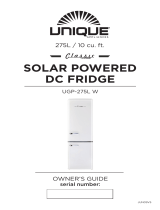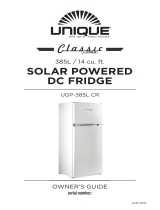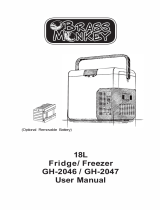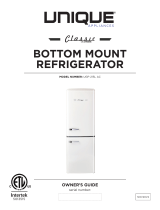
13
OPERATION continued
ADJUSTMENTS
As the ambient temperature changes with the season, it may be nec-
essary to adjust the thermostat to achieve the proper internal tem-
perature. If the room/ambient temperature approaches the appliance’s
internal operating temperature, the appliance will not function as it
should. The appliance will tend to run colder during these conditions
and it may be necessary to turn the thermostat to a warmer setting
(lower number). If the room/ambient temperature exceeds 100˚F
(38˚C), the appliance will not function as it should. The appliance will
tend to run warmer and it may be necessary to turn the thermostat to
a colder setting (towards the maximum setting).
OPENING AND CLOSING THE DOOR
The doors are fitted with uniform sealing strips to prevent warm air
and moisture from entering the fridge and freezer compartments.
Be sure that the doors and door seals are free from obstructions and
form a complete seal around the rim of the fridge/freezer cabinets.
Over-stung and/or unlevel installation of the appliance will prevent
a good seal.
It might be hard to open the door immediately after the door is closed.
This is due to air contraction in the fridge/freezer cabinets. This pres-
sure dierence will equalize in a few seconds, making the doors easy
to open once again.
LOADING THE FRIDGE AND FREEZER
A battery-powered refrigeration appliance has a cooling capacity
lower than typical AC appliances. Because the compressor is smaller,
the appliance runs more eciently but cools warm or room tempera-
ture food at a slower rate than an AC appliance.
Avoid packing food too tightly around the cooling plates located on
the back wall of the fridge/freezer. Allow air ow around these plates
to ensure proper operation.
When adding unfrozen food to the freezer for the first time, fill the
freezer only 1/3 full and wait until that food is suciently frozen
before adding more. It will also help to cool food more quickly if the
food is packaged in smaller containers rather than large ones. Food
packages more than 2 inches thick will cool slowly. Avoid placing
warm food in contact with cold food.
NORMAL OPERATING SOUNDS
• You may hear faint gurgling or bubbling sounds when the refrigerant
is being pumped through the refrigerant coils.
• When the compressor is on, the refrigerant is being pumped through
the appliance and you will hear a whirring or pulsing sound from the
compressor.
• A thermostat controls the compressor and you may hear a
‘click’ when the thermostat cuts in and out.

























